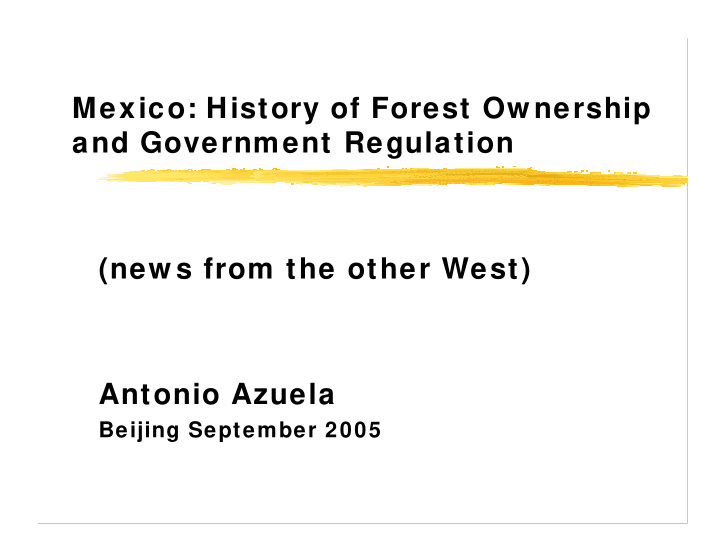



Mexico: History of Forest Ow nership and Government Regulation (new s from the other West) Antonio Azuela Beijing September 2005
A w ell kept secret � Is Mexico “in the vanguard of community forest movements worldwide”? Klooster and Ambinakudige (2005, 305)
…or an oximoron? � 80 % of Mexico’s forests are common property of peasant communities � High deforestation rates (500 000 hectares per year)
Mexico’s Biodiversity and the forest sector � Mexico’s biodiversity � 10% of terrestrial vertebrates in 1% of the earth’s land area � 70 pine species; 130 species of oak � Not a forest world power (annual production under 1% of GDP)
The origins of forest common property in Mexico � XVIth Century: The Spanish conquest and its territorial settlement � 1910-1980: The Mexican Revolution: land distribution [with a forest limbo]. � Since the 1980’s peasant communities take control of their forests
The tw o faces of the “Pueblos de indios” property system � Indigenous peoples were (brutally) subject to the Spanish Empire � And they were granted the right to own property “even if they were not Christians” (property as a human right)
The Great Hacienda: a major threat for the “Pueblos de indios” � Individual landowners (and their cattle) � 1521 – 1810: Indigenous communities lost part of their lands (but retained a large proportion of it)
19th Century Mexican liberalism: one big mistake � The suppression of all corporations (liberating the Church property and allowing peasants to become individual landowners) � A new opportunity for the great hacienda � A few families became owners of vast territories � Zapata, Pancho Villa and the grievances that gave meaning to the Mexican Revolution.
Let the pueblos have their “ejidos” back � Ejido : from the latin “exitus” (lands at the outskirts of a town) � A two tier agrarian reform � Restitution (or confirmation) of communal lands to the pueblos (now called comunidades ) � Granting of ejidos to new peasant groups (ejidos) � The outcome: 52% of the national territory, is owned by: � 27 000 ejidos � 2 800 comunidades
Forests and the Program of the Mexican Revolution � Land distribution with two features: � An agricultural bias (forests ignored) � Political clientelism (weak property rights) � Racial mixture ( Mestizaje ), a national goal � State control of strategic natural resources � 1938: Nationalization of the oil industry � State centralism, a condition for social reform
The forestry regime (up to the 1980’s) � Strict and centralized beaurocratic control of forest activities � Forest concessions, only to private companies (state owned companies, in the 70’s) � Forest bans in many regions (an ‘open access’ situation) � For peasant communities, only a stumpage fee � Conservation policies on community lands (national parks as if they were public)
From the stumpage fee to the community control over forests � A gradual strengthening of community rights over land and its resources � Gradual weakening of political dependence of communities vis-à-vis the state (transition to democracy) � Failure of state owned logging companies of the 70’s � Growing demands of communities to obtain the full benefits of their forests
Other contributing factors � Decentralization policies (since 1982) � Lawsuits against the renewal of forest concessions � New forest policies, toward ‘economies of scale’ � 1986, Forestry Law recognizes communities’ rights to obtain logging permits � 1992 ‘neo-liberal’ reform of Agrarian Law
A gross balance � 80 % of forests, owned by agrarian communities � Circa 8 000 forest communities in the country � Hundreds (?) of communities with effective control of their forest � Since 1996, state programs supporting community forest enterprises
Five types of forest communities (Bray et al) � Potential producers (no forest activities) � Stumpage communities � Roundwood communities � Sawmill communities � Finished products communities
Some achievments � In community forests, deforestation rates similar to those in natural protected areas � In 2003, 25 certified projects (6 in average in Brazil, Guatemala, Honduras, Germany, Canada and the USA) � Vertical integration: between 1986 and 1997 � Income from stumpage decreased 50 % � Income from sawnwood increased in 50 % (Antinori, 2000)
Main challenges � International competition � Migration � Social conflicts � Within communities (corruption / transparency) � Between neighboring communities � Ongoing tension between conservation and development policies � Doubts about the continuation of public policies supporting community forestry
Three Regulatory tensions � Federal vs state control � Growing interest by state governments in forest regulation � The temptation of forest bans. � Community control vs local government � Decentralization of two different kinds � Political representation vs property rights � De/regulation vs old fashioned bureaucracies � Can we control the pendulum?
Out of the paradox � Community forestry in Mexico, a new experience (less than three decades) � Based on an age/old property system
Recommend
More recommend